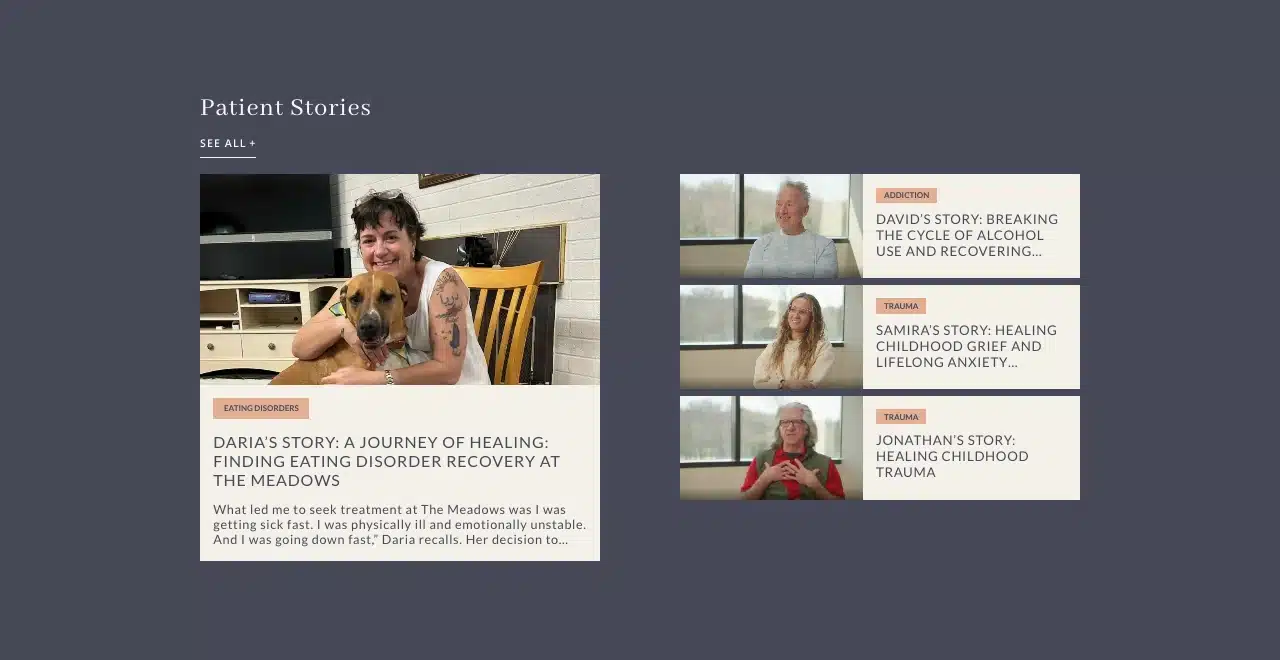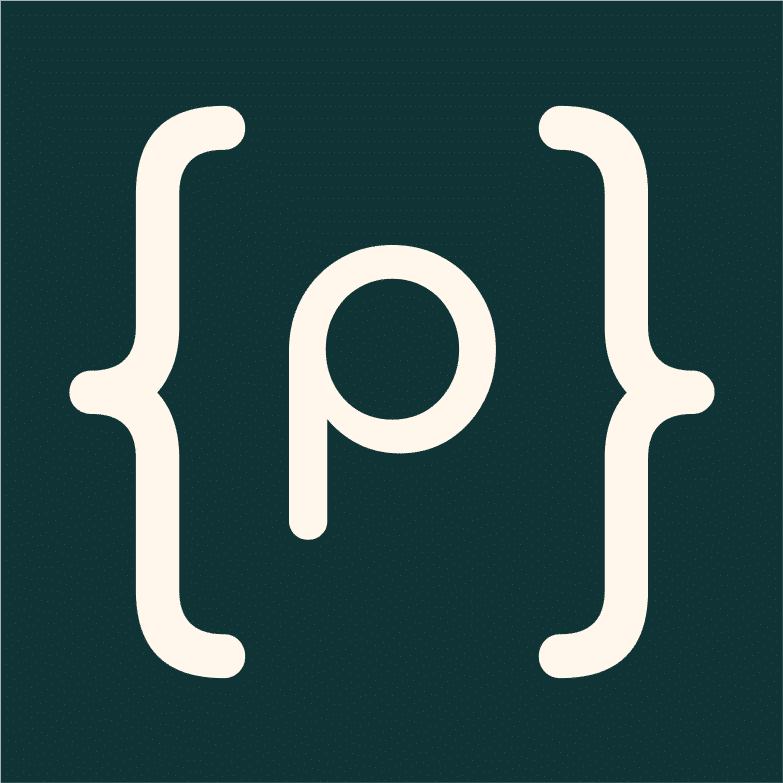Disclaimer: This project was completed during Rob’s tenure as the Technical Delivery Director at Astute Communications (2022-). Meadows Behavioral Healthcare was not, and is not, a client of Petrin Development Services.

Overview
Meadows Behavioral Healthcare represents one of the nation’s most established behavioral health organizations, with over 45 years of experience providing specialized treatment for trauma, addiction, eating disorders, and co-occurring mental health conditions. The organization operates multiple treatment facilities across the United States, including their flagship residential treatment center in Wickenburg, Arizona, located in the serene Sonoran Desert one hour northwest of Phoenix, along with outpatient centers and specialized programs nationwide.
As a leader in behavioral health treatment, The Meadows had accumulated an extensive library of educational content across multiple formats—blog posts, research publications, patient testimonials, video content, podcasts, and clinical resources. However, this valuable content ecosystem existed in fragmented silos, making it difficult for patients, families, and healthcare professionals to discover relevant materials efficiently. The organization recognized that their diverse multimedia content represented a primary differentiator in the behavioral health field, requiring a sophisticated platform that could unify disparate content types while maintaining the specialized taxonomy and user experience requirements unique to healthcare education.
The challenge extended beyond simple content organization: The Meadows needed a comprehensive Resource Library that could serve multiple audiences with varying access needs while supporting complex search functionality and intuitive content discovery across their entire educational ecosystem.
The Challenge
The Meadows Resource Library project represented a convergence of organizational transition, content management complexity, and evolving strategic priorities that extended well beyond typical website development timelines.
Extended Timeline with Organizational Change: What began as a standard website rebuild in late 2023 evolved into a comprehensive digital reorganization spanning over a year until early 2025. The project navigated multiple stakeholder transitions, each bringing philosophical shifts about digital strategy and content organization. The team managed changing requirements from a single organizational website to a multi-facility platform while maintaining development momentum across an unprecedented timeline.
Strategic Direction Evolution: Initial project scope focused on rebuilding The Meadows’ primary organizational website. However, organizational restructuring led to fundamental questions about digital architecture: Should the organization maintain one unified website for all facilities, or develop a distributed approach? How could content from multiple facilities be centralized while preserving SEO value and specialized functionality? These strategic decisions required flexible technical architecture that could adapt as organizational priorities evolved.
Content Ecosystem Complexity: The Meadows had developed substantial educational content across diverse formats including blog posts, clinical brochures, podcast episodes, patient testimonials, video content, and FAQ resources. However, these materials existed without unified organization or cross-content relationships. The challenge required developing sophisticated taxonomy systems that could accommodate specialized behavioral health terminology while enabling intuitive content discovery for diverse user audiences ranging from patients and families to healthcare professionals.
Multi-Audience Platform Requirements: The Resource Library needed to serve distinctly different user groups with varying access needs and content preferences. Patients and families required accessible educational resources, healthcare professionals needed clinical materials, and internal teams required content management workflows. Each audience demanded different filtering capabilities, content presentation formats, and user experience approaches while maintaining platform cohesion.
Technical Architecture Scalability: The project required managing thousands of individual content pieces while supporting complex search functionality, multiple content type templates, and sophisticated filtering mechanisms. The platform needed to accommodate content without traditional permalink structures (such as PDFs and FAQ items viewed in lightbox modals) while maintaining queryable database functionality and search engine optimization across the entire content ecosystem.
The Solution
The solution centered on developing a comprehensive Content Hub architecture that could unify disparate content types while delivering sophisticated discovery and management capabilities across The Meadows’ educational ecosystem.
Unified Content Architecture: Rather than attempting to retrofit existing content management approaches, the solution developed a specialized Content Hub system designed specifically for behavioral health educational materials. This approach created systematic content organization while preserving the flexibility to accommodate diverse content formats and evolving organizational requirements.
Multi-View Content Presentation: The Resource Library delivered content through multiple complementary interfaces: a streamlined Resource Library feed for browsing content by category and type, a comprehensive Resource Database with advanced filtering and search capabilities, and specialized views for testimonials and FAQs with dedicated taxonomies and user experiences tailored to specific content requirements.
Sophisticated Search and Filter Systems: The platform implemented multi-dimensional content discovery through advanced search functionality, content type filtering, category-based organization, and custom taxonomies specific to behavioral health topics. Users could navigate content through browsing-friendly feeds or database-style interfaces depending on their discovery preferences and information needs.
Technology Stack & Custom Development
The Meadows Content Hub required extensive custom development to create a specialized content management and discovery platform for behavioral health educational materials.
Core Platform:
- WordPress with Advanced Custom Fields Pro – Enterprise content management foundation with flexible field architecture for diverse content types
- Six Custom Post Types – Specialized content structures for blogs, brochures, videos, testimonials, FAQs, and podcast episodes
- Seven Custom Taxonomies – Sophisticated categorization system tailored to behavioral health education and treatment specializations
- Content Hub Block Library – Over two dozen specialized Gutenberg blocks with “ch-” prefix for Content Hub functionality
Content Hub Custom Development:
ch-resource-database– Comprehensive database view with advanced filtering, search, and content type organizationch-featured– Dynamic featured content presentation with customizable styling optionsch-type– Content type filtering system enabling users to browse by specific content formatsch-lightbox– Video content presentation with modal viewing and transcript integration capabilities- Custom search architecture supporting real-time filtering across multiple content dimensions
- Sophisticated taxonomy management enabling specialized categorization for behavioral health content
Content Management Infrastructure:
- Over a dozen custom plugins for content auditing, import automation, and metadata synchronization between staging and production environments
- Automated content import systems managing thousands of existing content pieces during platform migration
- Custom shortcode architecture replicating advanced functionality while maintaining content management flexibility
- Cross-environment content synchronization tools enabling development workflow management during extended timeline
Advanced Functionality:
- Lightbox modal systems for content without traditional permalink requirements (PDFs, videos with transcripts)
- Multi-dimensional search functionality enabling users to discover content through various pathways
- Content relationship mapping enabling cross-content discovery and related resource recommendations
- Performance optimization for handling large content databases while maintaining rapid search and filter response times
Implementation Strategy
Phased Content Migration: Rather than attempting bulk content migration, the solution implemented systematic import processes that could manage content integration alongside ongoing development. This approach enabled content team validation and approval workflows while maintaining staging environment synchronization for development review and stakeholder approval processes.
Development Environment Management: The extended timeline required sophisticated coordination between content import processes and custom development workflows. The solution managed content updates on production systems while reflecting changes in staging environments where new templates and functionality underwent client review and approval processes.
Scalable Template Architecture: The Content Hub system utilized a modular block-based approach that enabled rapid iteration and expansion. Each content type received specialized template development while maintaining consistent user experience patterns across the platform. This architecture facilitated adding new content types and functionality without disrupting existing content or user workflows.
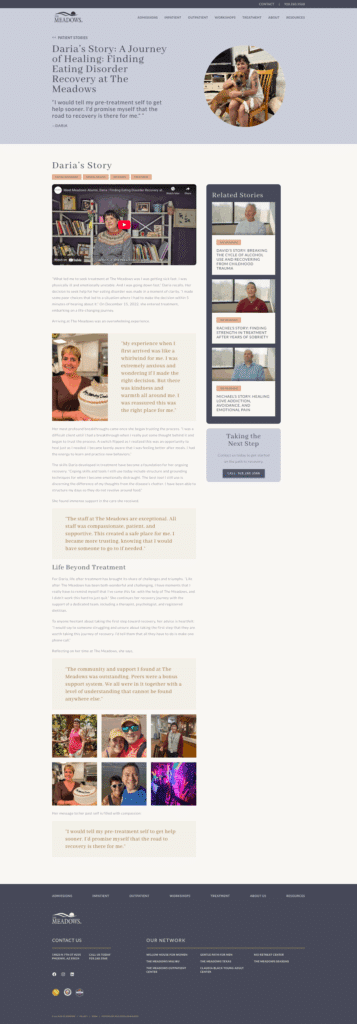
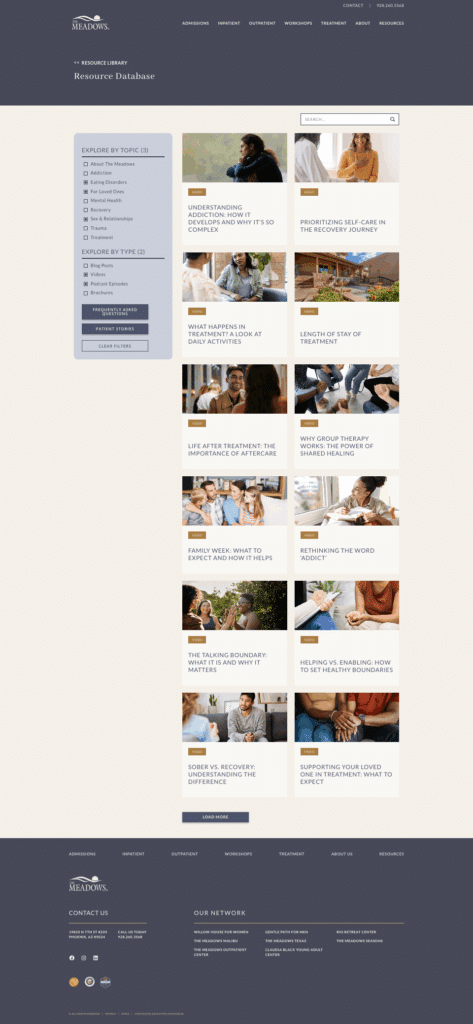
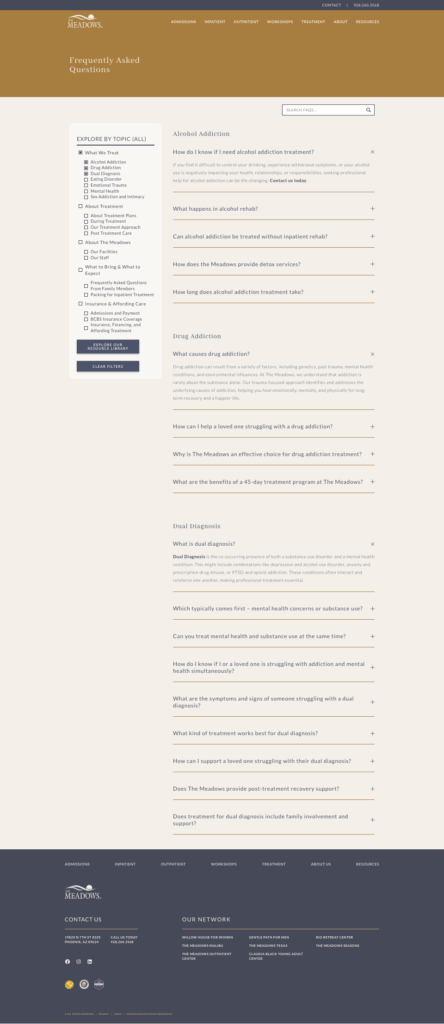
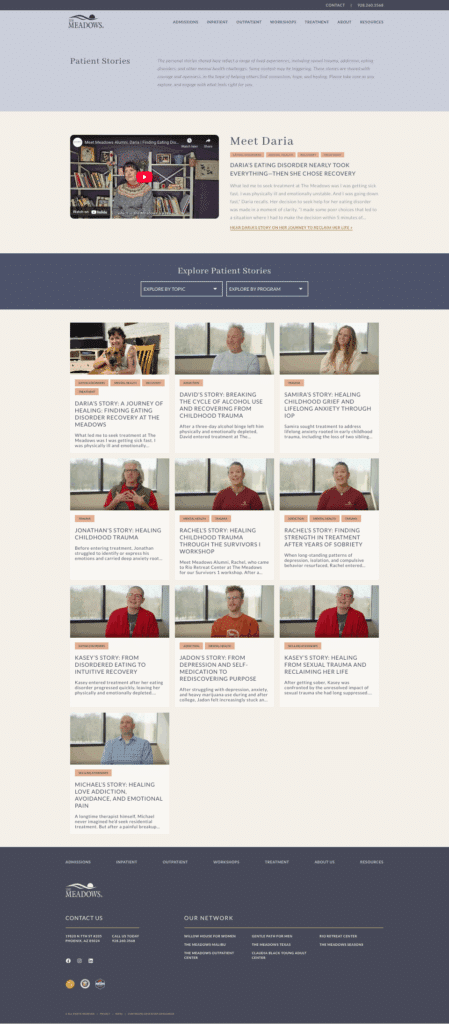
The Outcome
The Meadows Resource Library delivered a sophisticated content discovery platform that transformed how patients, families, and healthcare professionals access behavioral health educational materials. The Content Hub architecture successfully unified thousands of content pieces across multiple formats while providing intuitive navigation and advanced search capabilities that serve diverse user needs.
Platform Performance: The system delivers seamless content discovery across thousands of educational resources, with sophisticated filtering and search capabilities that enable users to find relevant materials through multiple discovery pathways. The platform maintains rapid response times while supporting complex database queries and real-time content filtering across multiple taxonomies and content types.
Content Management Excellence: The automated import and synchronization systems eliminated manual content migration challenges while providing robust workflow management for ongoing content updates. Content teams can efficiently manage diverse content types through unified administrative interfaces while maintaining specialized functionality for each content format.
Technical Architecture Success: The modular block-based development approach created a platform foundation that supports ongoing expansion and iteration. The Content Hub system demonstrates how specialized development can create maintainable, scalable platforms that serve complex organizational requirements while maintaining excellent user experiences.
Long-term Platform Durability: The Content Hub continues operating as a central resource for The Meadows’ educational content ecosystem, demonstrating the value of custom development approaches that prioritize architectural flexibility and long-term maintainability. The platform provides a foundation for continued content growth and organizational evolution while maintaining consistent user experiences across diverse content discovery needs.
The project exemplifies how sophisticated content architecture can transform educational resource management for specialized organizations, creating unified discovery experiences that serve multiple audiences while supporting complex content relationships and ongoing organizational development.


